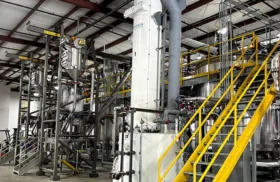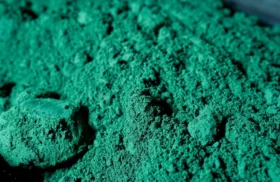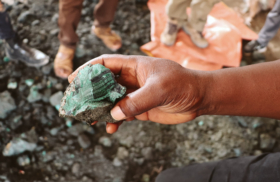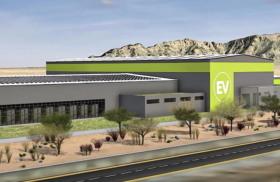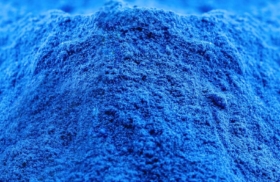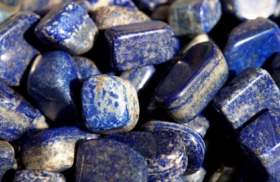
Cobalt, element 27 on the periodic table, slips neatly between iron and nickel in the first row of transition metals. Silvery-grey and unmistakably ferromagnetic, it packs a density of 8.90 g cm⁻³ and shrugs off heat with a melting point of 1 495 °C and a boiling point of 2 927 °C. Most remarkable is its Curie temperature—about 1 115 °C—which lets its magnetic order survive where iron’s gives up. In practice, that resilience turns cobalt into three very different industrial characters:
- Battery stabiliser – It “glues” the crystal lattice of high-energy lithium-ion cathodes, preventing thermal run-away.
- Superalloy workhorse – It hardens turbine and jet-engine alloys that sit in exhaust streams hotter than lava.
- Artist’s accomplice – As cobalt oxide, it’s the same pigment that once lent Mesopotamian glass beads—and later, Ming porcelain—their deep celestial blue.
Pure cobalt seams are rare. Roughly 98% of the metal emerges as the tag-along child of copper in the Katanga Copperbelt or nickel laterites in Indonesia and Cuba. That by-product status, combined with an often informal artisanal sector, leaves cobalt high on every supply-chain-risk index. The good news? It recycles beautifully. Modern hydrometallurgical loops reclaim more than 95% of contained cobalt while saving 60–70% of the energy a new tonne would cost.
History of Discovery and Use
The tale starts in 1735 when Swedish chemist Georg Brandt teased pure cobalt from “smalt” glass, proving the brilliant blue had nothing to do with bismuth impurities. It was the first metal discovered by science rather than inherited from antiquity.
Yet the colour itself is far older. Abbasid artisans were brushing cobalt-blue glazes onto glass a millennium ago, and 14th-century Chinese kilns perfected the blue-and-white Ming porcelain that travelled the Silk Road and wowed Renaissance Europe.
Fast-forward to the 20th century and cobalt’s palette broadened. Stellite and other Co-rich high-speed steels kept their hardness even when tools glowed red-hot. Cobalt-chromium alloys found a second life inside human hips. And superalloys such as Nimonic allowed gas-turbine blades to laugh at temperatures above 1 000 °C. Then came 1991 and Sony’s first commercial Li-ion battery—launching cobalt demand into a three-decade, 30-fold ascent.
Global Cobalt Production and Supply Dynamics
Global mine supply set another record in 2024 at roughly 290 kt of contained metal and looks set to breach 305 kt in 2025, says the USGS. The Democratic Republic of Congo (DRC) still owns three-quarters of that output, but Indonesia’s fast-tracked HPAL projects have carved a double-digit share in just five years.
Politics, alas, never sits quietly. In February 2025 Kinshasa slapped a four-month ban on unprocessed cobalt exports and is flirting with quotas—temporarily marooning up to 50 kt of feed and rattling markets. Analysts at Macquarie see small global surpluses of ~10 kt per year through 2025, but battery-grade sulphate is tighter, because refining is even more concentrated than mining.
China processes about 73% of the world’s cobalt intermediates, mostly in Zhejiang, Jiangsu, and Guangdong. Typhoons at Ningbo-Zhoushan or customs slow-downs in Lianyungang can reverberate through EV factories within days—a reminder that logistics is the new geopolitics.

Shutterstock
Leading Producer Companies
Major Producers
- Glencore plc (Democratic Republic of Congo) – From the twin SX-EW circuits at Mutanda and Katanga, Glencore shipped roughly 38 kt of refined cobalt in 2024 and is steering for 45–50 kt in 2025 as Mutanda’s Phase III pots come back online. Management is weighing an on-site sulphate line to dodge Chinese toll fees, with a go / no-go call pencilled in for late-2025.
- CMOC Group (Democratic Republic of Congo) – Tenke Fungurume and the fast-ramping Kisanfu mine together point to a towering 100–120 kt in 2025—close to 40 % of global supply. Kisanfu’s sulphide-leach plant was already running at 85 % of nameplate in Q2-25, and a decade-long offtake with LG Energy Solution locks in demand.
- Eurasian Resources Group (ERG) (Democratic Republic of Congo) – The Metalkol tailings retreatment and Chambishi refinery produced about 22 kt last year. A blockchain tool now tags every tonne for BMW and Umicore, and a 20 MW solar-fed SX train should add 5 kt of green capacity by 2027.
- Zhejiang Huayou Cobalt (Democratic Republic of Congo/Indonesia) – Deziwa and Kolwezi ores, plus Chinese and Indonesian refineries, yielded around 20 kt mined cobalt and more than 120 kt of precursor in 2024. A newly minted HPAL joint venture at Morowali has already shaved operating costs by 15 %.
- Jinchuan Group (Papua New Guinea/China) – Between the Ramu Ni-Co JV and the Gansu smelter, Jinchuan logged roughly 4 kt of cobalt-in-MHP and runs refining lines topping 10 kt. Hydromet upgrades aim to meet the EU battery-passport limit of 3 t CO₂e t⁻¹ by 2026.
- Vale Base Metals (Canada) – Voisey’s Bay underground feeds Long Harbour, which turned out ≈2.9 kt in 2024. A retrofit at Thompson should lift output to about 4 kt y⁻¹ from 2027, all on Manitoba hydro.
- Sumitomo Metal Mining (Philippines) – Taganito and Coral Bay HPAL plants delivered roughly 3.4 kt of cobalt-in-MHP in 2024. A converter in Ehime goes live in 2026, folding up to 5 kt of battery-grade sulphate into the supply chain.
- Chemaf Resources (Democratic Republic of Congo) – The Etoile tank-leach and Mutoshi SX-EW circuits produced about 6 kt last year. Construction on a 12 kt oxide concentrator starts in 2025, with first metal due H1-26. A U.S.-backed Orion–Virtus bid could bring non-Chinese capital into the mix.
Mid-sized Players on the Move
- Jervois Global (USA/Brazil) – Idaho Cobalt Operations plus the São Miguel Paulista refinery are slated for 3–4.5 kt y⁻¹ at full tilt, aided by U.S. Defense Production Act funds.
- Electra Battery Materials (Canada) – Its Ontario park targets 6 kt y⁻¹ of cobalt sulphate by 2026; Glencore has inked a feed MoU and Ottawa kicked in a CAD 5 m grant.
- Cobalt Blue Holdings (Australia) – The Broken Hill project aims for ≈3.5 kt y⁻¹ of mixed hydroxide from 2027; pilot work shows 85 % recovery via a roast-leach flowsheet.
- Giga Metals (Canada) – Turnagain could average ~16 kt y⁻¹ cobalt-in-concentrate; a Mitsubishi JV and hydro-powered fleet underpin a net-zero start-up plan (PFS due 2025).
- Sherritt International (Cuba/Canada) – The Moa joint venture and Fort Saskatchewan refinery should deliver ≈3.5 kt next year after a small expansion; a new briquette line will serve North-American cathode makers.

Shutterstock
Applications Driving Cobalt Demand
Refined demand cracked the 200 kt mark in 2024—up 14 % on the year—yet the market still closed with a 36 kt surplus. Rechargeable batteries soaked up three-quarters of all units: passenger EVs alone swallowed about 95 kt, a 21 % leap that overpowered the ongoing “thrifting” of cobalt in cathodes. Consumer electronics followed with roughly 27 kt, while stationary storage added another 16 kt as LFP systems spread across grid projects.
Aerospace-grade superalloys held on to a 9 % slice (≈18 kt), buoyed by the post-COVID flight rebound. Cemented carbide tools drew down around 12 kt, and a diverse tail—magnets, pigments, Fischer–Tropsch catalysts, paint driers—rounded out the balance.
Chemistry is tilting fast. Average cobalt intensity in EV batteries slipped to 0.6 kg kWh⁻¹ in 2024, down from 0.8 kg two years earlier, as NMC 811 and NCA plateau and LFP tops 40 % of China’s car market. Even so, larger packs and a 30 % jump in BEV sales kept total tonnes rising. Looking ahead, high-manganese and cobalt-free LMFP cathodes could cap demand growth at roughly 3 % a year through 2030—unless solid-state designs pull cobalt back into the spotlight.
Regulation is closing the loop. Europe’s Battery Regulation mandates 16 % recycled cobalt in new cells by 2030 and 26 % by 2035; China wants at least 20 kt of secondary cobalt by 2027. North-American recyclers, led by Redwood Materials and Li-Cycle, have 25-kt hydromet plants on the drawing board, potentially erasing a tenth of the primary growth wedge. The upshot: cobalt use will keep expanding, but every future tonne will need to be leaner on carbon and richer in traceability.
Cobalt Market Analysis and Price Trends
On 10 July 2025 the LME cash contract settled at USD 33 335 t—23% off last year’s floor yet still 60% below the 2022 spike. Inside China, Benchmark’s battery-grade sulphate sat at RMB 48 000–52 000 t (USD 6 670–7 230 t) on 9 July, nudging 1% week-on-week.
Forecasts for 2025 bunch around USD 31 000–34 000 t. Bears point to small surpluses; bulls cite refined bottlenecks, DRC policy darts, Indonesia’s HPAL surge, shifting cathode chemistries (from cobalt-lean LFP to cobalt-rich NCA), and talk of fresh Western stockpiles.
Investment Opportunities in Cobalt
- Strategic stockpiles – The U.S. Defense Logistics Agency and several EU governments may follow China’s reserve playbook—price-insensitive buying that floors the market.
- Recycling upside – EU rules mandating recycled content could triple secondary cobalt supply by 2030, fattening margins for closed-loop refiners.
- Down-cycle entry – Spot prices remain 60% below the 2022 high—fertile ground for contrarians if surpluses ebb.
- ESG premiums – Automakers now pay extra for cobalt traced end-to-end and guaranteed free of child labour. Blockchain is becoming more than marketing hype.
Future Outlook
Models from Benchmark and the Cobalt Institute converge on ≈ 350 kt y⁻¹ demand by 2030—a 7% CAGR—with EVs grabbing 57%. Short-term oversupply may linger, but the DRC-Indonesia duopoly keeps geopolitics, ESG, and price risk alive. High-manganese or LFP cathodes cap the upside, yet nickel-rich chemistries still power long-range vehicles, and aerospace superalloys have no practical substitute. In the medium term, the ceiling on cobalt prices will be set by low-carbon refining tech, higher recycling rates, and clever substitution—if any.

Shutterstock
Frequently Asked Questions (FAQ)
Why is cobalt essential for high-performance Li-ion batteries?
It stabilises high-nickel layered oxides, allowing fast charging and long cycle life above 4.3 V.
Where is cobalt mined and refined?
Roughly 76% is mined in the DRC, and about 73% is refined in China.
Who are the largest producers?
CMOC, Glencore, and ERG lead the mining side; Huayou and Jinchuan dominate refining.
How do low-cobalt batteries affect demand?
Cobalt per kWh is falling, but total demand still rises because battery output is growing faster.
What drives cobalt prices in 2025?
DRC export policy, Indonesian HPAL growth, cathode mix, and strategic stockpiling.
Is recycled cobalt equivalent to primary metal?
Yes—closed-loop hydrometallurgy yields battery-grade sulphate or metal indistinguishable from primary.
What are the ESG issues with artisanal mining?
Safety hazards, child labour, and environmental harm. Independent audits aim to block such material from OEM supply chains.
How can investors gain exposure?
Physical metal, mining equities, streaming or royalty deals, recycling specialists, or critical-minerals ETFs.
